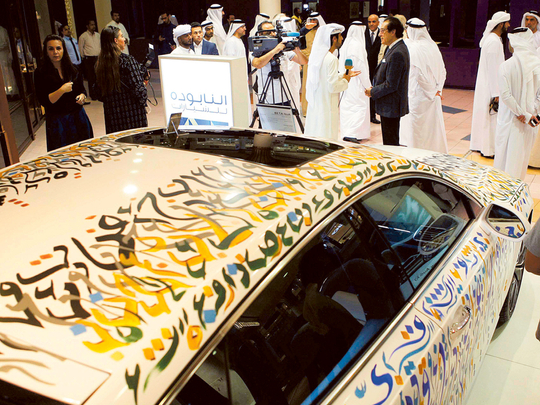
Dubai: A massive selection of calligraphy masterpieces revealing the beauty of each letter of the Arabic language is now on display at Wafi Mall and will give visitors an opportunity to gain deep insights into the history, trends, and cultural significance of calligraphy.
Organised by Dubai Culture and held under the patronage of Shaikh Hamdan Bin Mohammad Bin Rashid Al Maktoum, Crown Prince of Dubai and Chairman of the Dubai Executive Council, the eighth International Arabic Calligraphy Exhibition will showcase works by more than 50 accomplished artists from across the world until May 15.
The exhibition features modern and classical forms of calligraphy by different calligraphers and designers in different sections of the mall, as well as a selection of works from the collection of His Highness Shaikh Mohammad Bin Rashid Al Maktoum, Vice-President and Prime Minister of the UAE and Ruler of Dubai.
Bringing together brilliant forms of Arabic calligraphy together in one place, such as the modern and classical, according to Dr Salah Al Qasim, Adviser to Dubai Culture, is a way for visitors to gain insight into how calligraphy has evolved and attract a young audience, who are mostly interested in modern forms.
“Arabic calligraphy is a deep part of the Arabian heritage and culture and is the origin of the Arabic language. This exhibition is in line with Shaikh Mohammad’s vision in preserving and reinforcing the Arabic language,” he said. “Such cultural events highlight the beauty of our language and educates youth and calligraphy enthusiasts through the workshops about the techniques used in calligraphy.”
Dr Al Qasim said that the UAE has played a big role in reviving this art form over the years and has put in a lot of effort to bring it back in the spotlight.
As part of the month-long exhibition, there will be more than 70 expert workshops for the public to learn more about calligraphy.
Fatima Mohammad Abdul Rahman, a classic Emirati calligrapher known as Joori, said she will be leading two workshops on the Kufic Fatimid script and give a basic introduction to the different calligraphic scripts.
“The culture of writing began to spread as part of the efforts of Prophet Mohammad (PBUH) and it continued to spread until Arabic calligraphy began to be formed and be used as a form of decoration using verses from the Quran on mosques and other art pieces,” she said. “Arabic calligraphy is still popular to this day, but has its own interested audience.”
Fatima believes that the art of calligraphy has encouraged many people to learn the Arabic language, “and so to get our youth to love this art will get them to love their language more”.
Wissam Shawkat, a renowned Iraqi designer who lives in the UAE and works with modern and classical forms of calligraphy, including typography and logo designs, explained the difference between the two art forms.
“Arabic calligraphy started to take shape by writing the word of God, the Quran, this is what made it prosper and evolve to be used as a form of decoration. Classical calligraphy is a fixed form of calligraphic styles that have been perfected over hundreds of years, while the modern is free of rules and depends on the artist’s own rules” said Shawkat, who is displaying two of his classical works.
He believes the exhibition is a leading one in the region and the way it has been organised has made it so special.
An interesting section of the exhibition is also showcasing sections of the Quran of the late King Hussain of Jordan that features engravings in Maliki Islamic style calligraphy.
The exhibition was inaugurated on Tuesday by Shaikh Nahyan Bin Mubarak Al Nahyan, Minister of Culture, Youth, and Community Development.











